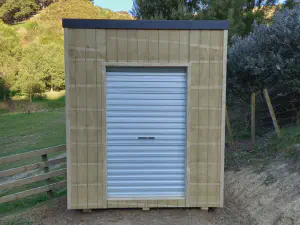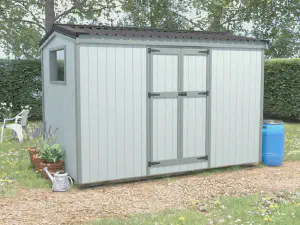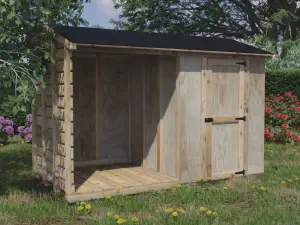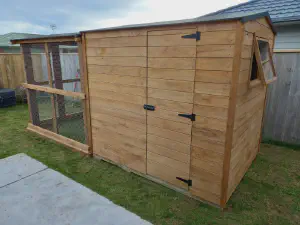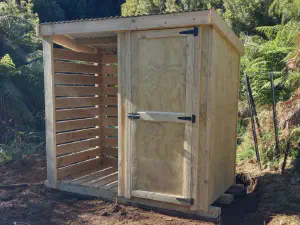Garden Sheds & Lifestyle Sheds
In a world where flimsy garden sheds seem to multiply like dandelions in spring, our aim is to design and build garden sheds the way they used to be: strong, durable and practical.
Let’s be honest — in today’s market, finding a garden shed that won’t crack and crumble faster than a house of cards in a gentle breeze can be trickier than catching a greased pig at a country fair. Which is why we came up with a list of 14 Questions to Ask When Buying a Garden Shed. Forewarned is forearmed!
In case you’re thinking of building your own garden shed or opting for a kitset, you may want to consider the pros and cons of each option first. We’ve outlined the most important ones here: Garden Sheds: DIY vs Kitset vs Fully Assembled - Pros and Cons
Also, be sure to check out the frequently asked questions at the bottom of this page.
Here are a few of the garden sheds we’ve designed so far. Let us know if have any questions or if you’re after a different shape or size and we will do our best to help you find the perfect shed for your needs.
Margo A
Tom Good
Jerry
Brer Rabbit
Robin Tack
Frequently Asked Questions
Where and how do I look for a sturdy, durable and affordable storage shed?
Most people don’t look further than their nearest Mitre 10 or Bunnings store, and often end up regretting their decision the moment their “cheap” kitset arrives. Here are some tips for finding a quality storage shed at an affordable price:
-
You can’t find what you can’t recognize. You need to educate yourself on how to appreciate quality, what to look out for, and especially what to avoid. You may find our 14 Questions to Ask When Buying a Garden Shed helpful in honing your discernment skills.
-
You can’t find unless you look in the right place. There are good shed builders out there, but they are more often than not small compared with the big box stores, too small to be seen and heard, unless you go looking for them. A good place to start is by going online and by looking a bit further than the first page on Google. Try looking on page 2 or 3 or 4, and you’ll be surprised what you may find!
-
You need to learn from other people’s experiences. Every time you come across a shed or builder you like, go online and read a few reviews. Ask yourself, have other people been happy with this shed or builder? Be careful though, as there are many fake and useless reviews out there. Look for the ones where customers took the effort to describe their experience. You may need to look further than the company’s own website, like for example Google Reviews.
The important thing to remember is that there are good quality garden sheds on the market, often at a similar or even better price than the standard flimsy kitset hovels that have flooded the New Zealand market, but it takes a little time and effort to find them.
What to look out for in a quality wooden shed?
In a nutshell, a wooden shed needs to be made of sturdy and durable materials, with good craftsmanship and best practices. For example:
-
Make sure the framing timber is sturdy enough for purpose. Framing timber comes in different sizes, with 90x45mm strong enough to build a modern house and 45x45mm cheap enough for cheapskate builders.
-
Make sure there is enough framing timber to support the basic structure, i.e. floor, walls and roof. A common and widely accepted distance between studs in a sturdy building is 600mm, but one flimsy
toothpickstud every two meters is unacceptable. -
Make sure the cladding is thick enough so it won’t split, warp, dent or break under normal use.
-
Look out for possible ways that water could enter, which will affect your garden tools, bikes, quad or whatever else you may wish store.
-
Make sure the roof is adequately supported.
-
Make sure all the wood is sufficiently treated, preferably H4 for the bearers (underneath the floor) and at least H3 for all other timber.
-
Check also the quality of craftsmanship. It tells you a lot about the focus of the shed builder, i.e. speed and profit for the seller or satisfaction for the buyer.
For more detailed tips and examples, be sure to check out our 14 Questions to Ask When Buying a Garden Shed.
What are some good uses for a garden shed?
The list of uses for a sturdy and well constructed garden shed are endless, but here are a few ideas we’ve come across:
-
Storing gardening tools, power tools, kids bikes, quad bikes, etc.
-
As a workshop or tool shed, especially to free up the garage or spare room in the house.
-
As a cabin or sleepout, like some of our customers did with our Tom Good garden shed. If you want to add insulation, make sure you get a shed that has a decent frame that allows you to add insulation and internal lining. Most kitsets we’ve seen on the market are not suitable for this.
-
As a home office or hobby room. Same as above, a good builder with a good product should be able to add insulation without too much extra effort or expense.
-
To house pets and other animals, like for example our Brer Rabbit and Pigeon Perfect sheds. Make sure though that your shed is strong enough to take a few bumps and scrapes.
-
To store animal feed, like dog food or calf milk powder.
Do I need to paint or stain my wooden shed?
Since we only use treated timber for our sheds, there is no need to paint or stain it. However, it can often make a wooden shed look better and blend in with other buildings, and it does extend it’s lifespan by protecting the wood from the weather.
